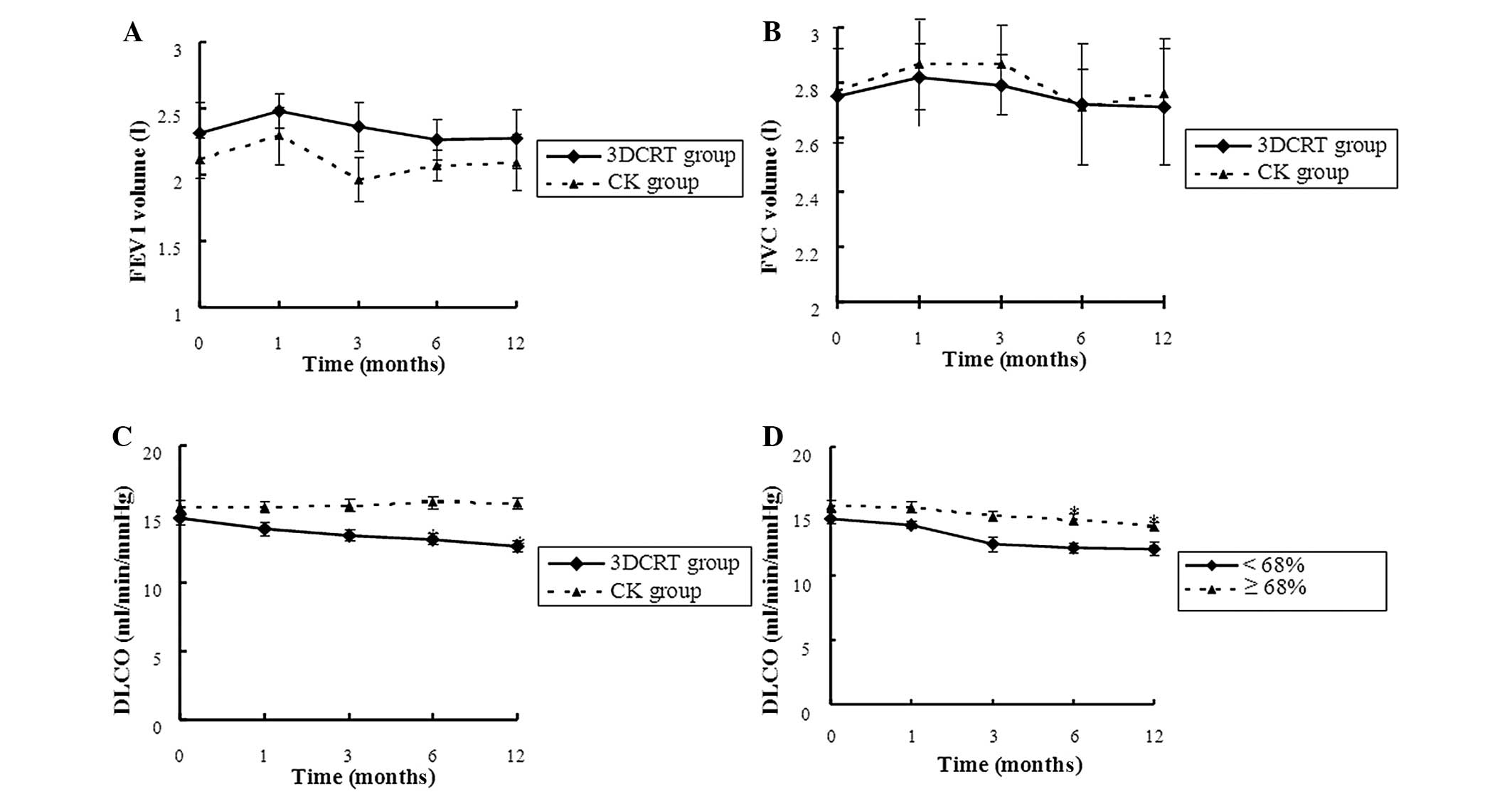|
1
|
Qiao X, Tullgren O, Lax I, et al: The role
of radiotherapy in treatment of stage I non-small cell lung cancer.
Lung Cancer. 41:1–11. 2003. View Article : Google Scholar : PubMed/NCBI
|
|
2
|
Rodrigues G, Lock M, D'Souza D, et al:
Prediction of radiation pneumonitis by dose-volume histogram
parameters in lung cancer - a systematic review. Radiother Oncol.
71:127–138. 2004. View Article : Google Scholar : PubMed/NCBI
|
|
3
|
Brown WT, Wu X, Fayad F, et al: Cyber
Knife radiosurgery for stage I lung cancer: results at 36 months.
Clin Lung Cancer. 8:488–492. 2007. View Article : Google Scholar : PubMed/NCBI
|
|
4
|
van der Voort van Zyp NC, Prévost JB,
Hoogeman MS, et al: Stereotactic radiotherapy with real-time tumor
tracking for non-small cell lung cancer: clinical outcome.
Radiother Oncol. 91:296–300. 2009. View Article : Google Scholar : PubMed/NCBI
|
|
5
|
Timmerman R, Paulus R, Galvin J, et al:
Stereotactic body radiation therapy for inoperable early stage lung
cancer. JAMA. 303:1070–1076. 2010. View Article : Google Scholar : PubMed/NCBI
|
|
6
|
Collins BT, Vahdat S, Erickson K, et al:
Radical cyberknife radiosurgery with tumor tracking: an effective
treatment for inoperable small peripheral stage I non-small cell
lung cancer. J Hematol Oncol. 2:12009. View Article : Google Scholar : PubMed/NCBI
|
|
7
|
Banovac F, McRae D, Dieterich S, et al:
Percutaneous placement of fiducial markers for thoracic
malignancies. Robotic Radiosurgery: Treating Tumors that Move with
Respiration. Urschel HC, Kresel JJ, Luketich JD, Papiez L and
Timmerman RD: Springer-Verlag; Berlin: pp. 15–29. 2007
|
|
8
|
Yousefi S, Collins BT, Reichner CA, et al:
Complications of thoracic computed tomography-guided fiducial
placement for the purpose of stereotactic body radiation therapy.
Clin Lung Cancer. 8:252–256. 2007. View Article : Google Scholar : PubMed/NCBI
|
|
9
|
Radiation Therary Oncology Group, . Acute
radiation morbidity scoring criteria. http://www.rtog.org/ResearchAssociates/AdverseEventReporting/AcuteRadiationMorbidityScoringCriteria.aspxAccessed.
May 1–2012
|
|
10
|
Radiation Therapy Oncology Group/European
Organization for Research Treatment of Cancer, . Late radiation
morbidity scoring schema. Available at. http://www.rtog.org/ResearchAssociates/AdverseEventReporting/RTOGEORTCLateRadiationMorbidityScoringSchema.aspxAccessed.
May 1–2012.
|
|
11
|
Therasse P, Arbuck SG, Eisenhauer EA, et
al: New guidelines to evaluate the response to treatment in solid
tumors. European Organization for Research and Treatment of Cancer,
National Cancer Institute of the United States, National Cancer
Institute of Canada. J Natl Cancer Inst. 92:205–216. 2000.
View Article : Google Scholar : PubMed/NCBI
|
|
12
|
Vahdat S, Oermann EK, Collins SP, et al:
Cyber Knife radiosurgery for inoperable stage IA non-small cell
lung cancer:18F-fluorodeoxyglucose positron emission
tomography/computed tomography serial tumor response assessment. J
Hematol Oncol. 3:62010. View Article : Google Scholar : PubMed/NCBI
|
|
13
|
Collins BT, Erickson K, Reichner CA, et
al: Radical stereotactic radiosurgery with real-time tumor motion
tracking in the treatment of small peripheral lung tumors. Radiat
Oncol. 2:392007. View Article : Google Scholar : PubMed/NCBI
|
|
14
|
Mehta M, Scrimger R, Mackie R, et al: A
new approach to dose escalation in non-small-cell lung cancer. Int
J Radiat Oncol Biol Phys. 49:23–33. 2001. View Article : Google Scholar : PubMed/NCBI
|
|
15
|
Robnett TJ, Machtay M, Vines EF, et al:
Factors predicting severe radiation pneumonitis in patients
receiving definitive chemoradiation for lung cancer. Int J Radiat
Oncol Biol Phys. 48:89–94. 2000. View Article : Google Scholar : PubMed/NCBI
|
|
16
|
Kocak Z, Borst GR, Zeng J, et al:
Prospective assessment of dosimetric/physiologic-based models for
predicting radiation pneumonitis. Int J Radiat Oncol Biol Phys.
67:178–186. 2007. View Article : Google Scholar : PubMed/NCBI
|
|
17
|
Lind PA, Marks LB, Hollis D, et al:
Receiver operating characteristic curves to assess predictors of
radiation-induced symptomatic lung injury. Int J Radiat Oncol Biol
Phys. 54:340–347. 2002. View Article : Google Scholar : PubMed/NCBI
|
|
18
|
Marks LB, Bentzen SM, Deasy JO, et al:
Radiation dose-volume effects in the lung. Int J Radiat Oncol Biol
Phys. 76 (Suppl 3):S70–S76. 2010. View Article : Google Scholar : PubMed/NCBI
|
|
19
|
Lopez Guerra JL, Gomez D, Zhuang Y, et al:
Change in diffusing capacity after radiation as an objective
measure for grading radiation pneumonitis in patients treated for
non-small-cell lung cancer. Int J Radiat Oncol Biol Phys.
83:1573–1579. 2012. View Article : Google Scholar : PubMed/NCBI
|
|
20
|
Prevost JB, Voet P, Hoogeman M, et al:
Four-dimensional stereotactic radiotherapy for early stage
non-small cell lung cancer: a comparative planning study. Technol
Cancer Res Treat. 7:27–33. 2008. View Article : Google Scholar : PubMed/NCBI
|
|
21
|
Gouders D, Maingon P, Paesmans M, et al:
Exclusive radiotherapy for non-small cell lung cancer. A
retrospective multicentric study. Rep Pract Oncol Radiother (Polish
Soc Rad Oncol). 8:7–14. 2003. View Article : Google Scholar
|
|
22
|
Sibley GS, Jamieson TA, Marks LB, et al:
Radiotherapy alone for medically inoperable stage I non-small-cell
lung cancer: the Duke experience. Int J Radiat Oncol Biol Phys.
40:149–154. 1998. View Article : Google Scholar : PubMed/NCBI
|
|
23
|
Chen VJ, Oermann E, Vahdat S, et al: Cyber
Knife with tumor tracking: an effective treatment for high-risk
surgical patients with stage I non-small cell lung cancer. Front
Oncol. 2:92012. View Article : Google Scholar : PubMed/NCBI
|















